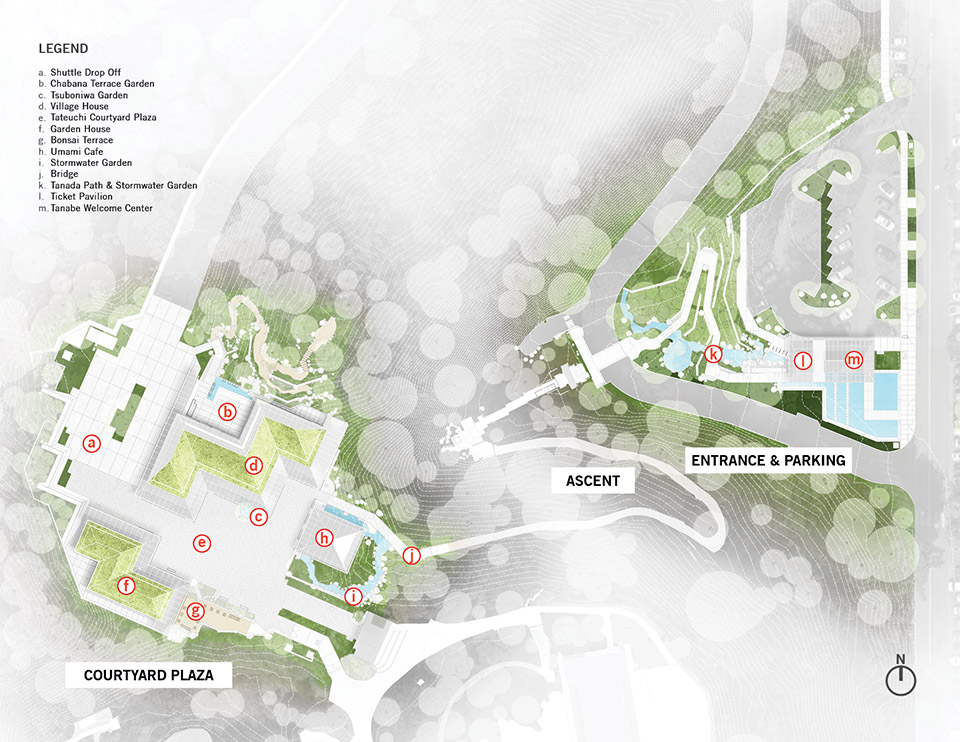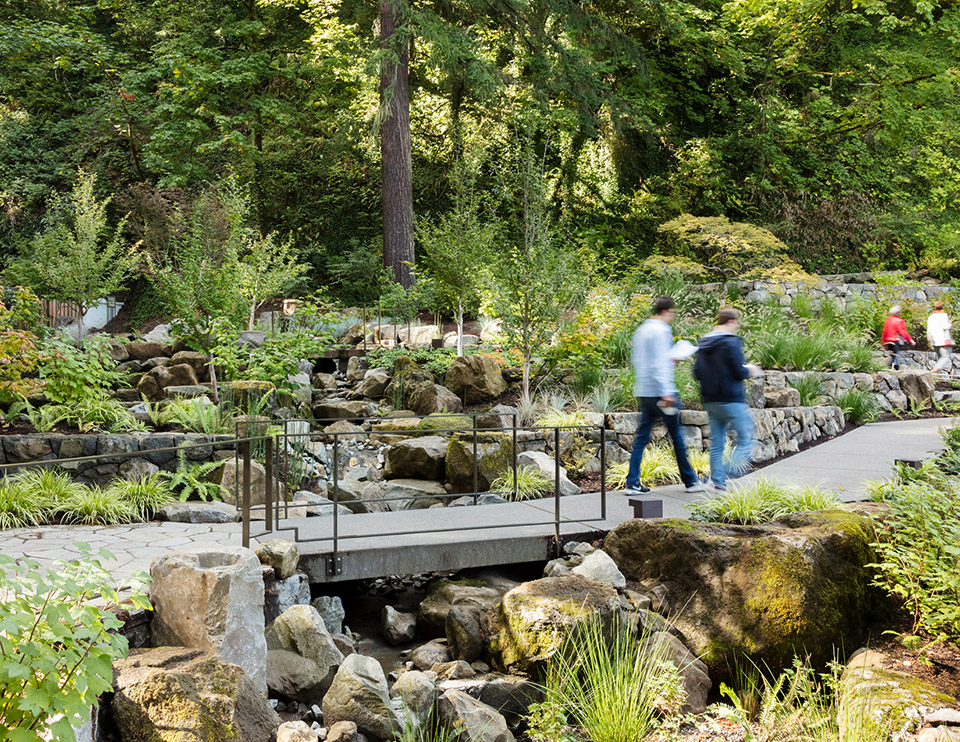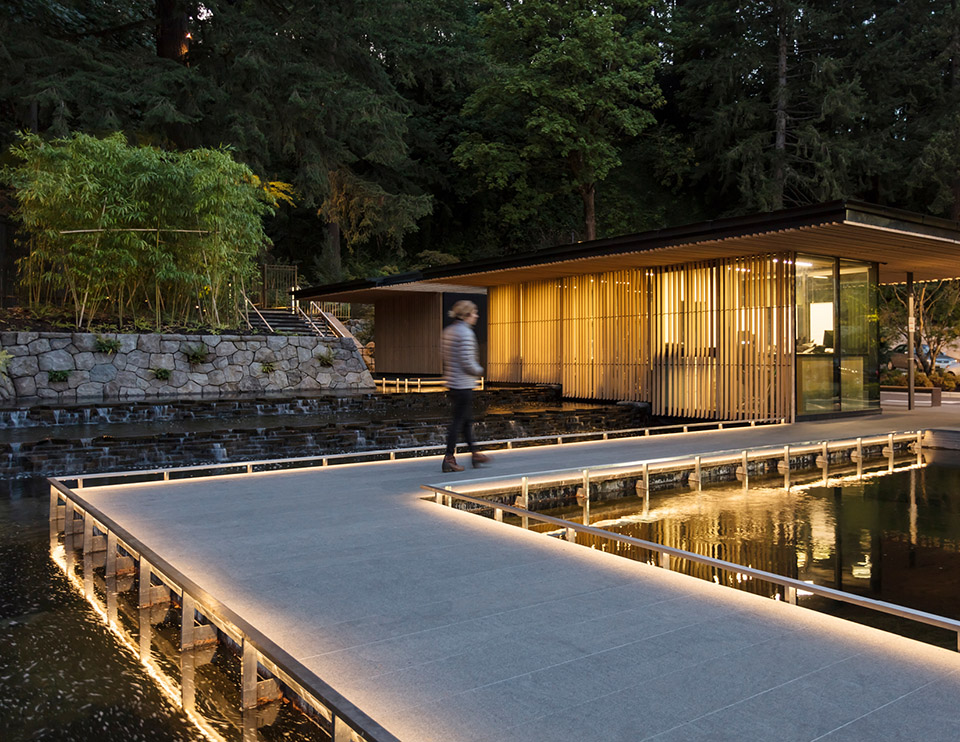地址:北京市海淀區中關村北大街100號(北樓)北京大學建筑與景觀設計學院一層 Email:info@landscape.cn
Copyright ? 2013-2022 景觀中國(www.36byz.com)版權所有 京ICP備05068035號
 京公海網安備 110108000058號
京公海網安備 110108000058號
“波特蘭日本花園是擁有50多年歷史的著名景觀勝地。在經歷了一次擴建之后,花園內的新舊元素被完美地融合在一起。景觀設計師并未簡單地選擇保護的策略,而是將日本的傳統技術與現代材料進行了結合。繼承了家傳技藝的石匠利用當地的花崗巖為花園打造出城堡般的墻壁。重新規劃的入口和到達路徑沿著蜿蜒的林間小路沿著坡地上升了90英尺的高度,最終抵達由隈研吾設計的一系列亭閣。這些亭閣的屋頂均種有綠植,并搭配以雨水滯留和再循環系統,保證了新花園能夠一直延續到未來。”
– 2020年評審委員會
“Within the Portland Japanese Garden—already a celebrated set of landscapes more than five decades old—an expansion blends together new and old seamlessly. Yet instead of simply adopting a preservation strategy, the landscape architects employed traditional Japanese techniques with contemporary materials; stonemasons with a long lineage produced the garden’s castle-like walls using local granite. A freshly choreographed entry and arrival sequence gently ascends 90 feet of grade along an accessible wooded switchback pathway to arrive at a sublime set of pavilions designed by Kengo Kuma; these feature planted rooftops alongside stormwater retention and recirculation systems that promise to sustain the new gardens well into the future.”
– 2020 Awards Jury
PROJECT STATEMENT
文化交匯口是一個積極鼓勵跨文化交流與實踐學習的場所。雖然波特蘭日本花園已經是一個足夠著名的地標,且被認為是日本以外最正宗的日式庭園之一,此次的擴建工作仍然在很大程度上相異于傳統日本花園的設計。文化交匯口創造了一種將生態原則、高性能可持續技術與現代日式設計美學相融合的環境,為廣受社會認可的世界級教育項目提供了背景。文化交匯口通過其優雅而現代的空間恢復了曾經受到沖擊的、地質復雜的景觀,為日本文化和技藝的學習營造出一個沉浸式的互動環境。
The Cultural Crossing project is a place of inspired intercultural exchange and dynamic hands-on learning. While the project is an expansion of the existing Portland Japanese Garden, already a celebrated landmark known as one of the most authentic Japanese gardens outside of Japan, it diverges significantly from traditional Japanese garden design. Cultural Crossing creates a setting in which ecological principles and high-performance sustainable techniques blend with the aesthetics of modern Japanese design, and become the backdrop for a socially dynamic, world-class educational program. The elegant, contemporary spaces of the Cultural Crossing also restored the impacted, geologically complex landscapes of the site, and transformed the space into an immersive and interactive environment to learn about Japanese culture and craft.

▲文化交匯口項目涵蓋了3.4公頃的新空間,包括一個新的入口亭閣、池塘和重新規劃的、通往中央廣場的入口路徑。廣場周圍分布著三座新建筑,以及一系列花園空間、露臺和步道。Cultural Crossing: Cultural Crossing includes 3.4 acres of new spaces, including a new entry pavilion, pond, and redeveloped entry path that ascends to a central plaza flanked by three new buildings, numerous garden spaces, terraces, and paths.
PROJECT NARRATIVE
位置和場地范圍
“文化交匯口”鑲嵌在華盛頓公園內的一處綠樹成蔭的坡地上。該公園包含眾多旅游景點,并且有著重要的歷史意義。“文化交匯口”項目占地3.4英畝,包括一個新的入口亭閣、池塘以及重新規劃的到達路徑。其中,到達路徑一路上生至中央廣場,廣場周圍坐落著三座新建筑,提供了多樣化的室內和室外空間,作為教學、集會和演講的場所。場地跨越了90英尺高的垂直距離,令“文化交匯口”成為華盛頓公園森林頂端的、環境幽靜的藝術和文化體驗場所。具有視覺沖擊力的景觀設計被融入到針對復雜場地條件而提出的解決方案當中,同時結合了地質、雨水和可持續設計方面的功能。
重構日本花園
在我們不斷擴張的全球化世界里,“文化交匯口”以一種前所未有的方式重新定義了傳統日式園林的作用:除了提供沉思式的花園體驗之外,還扮演著一個強大的教育、闡釋和多元文化的中心。為了實現這一大膽的提議,景觀設計師將當代日本設計、西方的場地開發模式以及對環境高度敏感的基礎設施建造方法進行了融合。在該項目中,花園本身對于保護日本園藝傳統所起到的作用甚至超過了博物館建筑,因其融合了現代的設計理念與環境敏感的開發方式,同時還為游客提供了學習日本藝術與文化的機會。項目還強調了無障礙設計,在改善游客體驗的同時,展示了以公平方式實現文化交流的重要性。重新定義游客體驗
重新營造游客體驗
改造的首要內容是建立明確的到達次序。在原來,游客需要穿越停車場、馬路和服務庭院進入場地。在重新設計之后,客人們從旅程的一開始便能夠收獲到豐富的體驗,并隨著空間的序列逐步深入場地。在山腳下,新建立的Tanabe歡迎中心(Tanabe Welcome Center)提供了更加正式和吸引人的入口。游客們可以經由人行道穿越森林峽谷和跌落式的雨水花園,最終到達頂部的文化村(Cultural Village)。
文化交流與教育場所
文化村由三座新建筑和中央的Tateuchi庭院廣場構成。這三座建筑分別是漂浮在峽谷之上的Umami茶館、容納了Tanabe畫廊、多功能教室、花園禮品店及Vollum圖書館的村屋(Village House),以及容納了手工坊、工作室和管理人寓所的花園屋(Garden House)。庭院的外緣隨處可見傳統日本庭園的設計元素,包括盆栽露臺、Tsuboniwa花園和石砌圍墻等,使開放空間成為設計中的亮點。一系列全新的空間為各種課程、培訓和活動的舉辦創造了條件。此外,文化村還增設了包括講座、研討會和園藝課程在內的一系列教學計劃。建筑物的設計充分尊重了景觀,試圖與自然環境充分交融。室內外空間的緊密連接為游客帶來通透而流暢的沉浸式體驗,同時能夠很好地適應各類文化活動和課程對場所的不同要求。
傳統安裝方法與當代材料相結合
雖然空間的設計都具有明顯的現代特征,項目團隊還是盡可能地結合了傳統的施工和安裝方法,以強調古代記憶與現代設計背景的持續關聯。景觀設計師、設計團隊成員和承包商所面臨的共同挑戰是,如何將傳統的方法恰當地轉化為適合建造的前沿項目。為了維持庭園區域內既有的日本傳統特征,“文化交匯口”選擇了產自本地的材料和植物,其中石頭等材料均是從當地資源中經由人工挑選。位于廣場西緣的中世紀城堡圍墻是結合傳統與現代方法的一個值得注意的例子:它是由一位日本傳統石匠(第15代傳人)使用當地出土的東俄勒岡貝克藍色花崗巖砌筑而成。
地質和環境影響
環境管理是該項目的一個統一主題,而場地本身在環境和地質上的復雜程度也讓文化交匯點成為了創新設計及場地開發方式的典范。由綠色屋頂、雨水收集和本土花園構成的系統將各個空間連接在一起,最大程度地降低了地質風險、提高了水質,同時讓游客們意識到自身在保護自然環境方面所肩負的責任和作用。
一部分平臺、花園和建筑物被建造在曾經發生過滑坡的地點,其布局旨在盡可能地減少地層移動帶來的影響,并防止滑坡速度的增加。團隊開發了一個全面的雨水收集系統,以限制可能加速滑坡的雨水滲透,同時利用收集到的水創造了一個額外的雨水花園展示區,作為貫穿場地的季節性特色景觀。
文化交匯口被華盛頓公園廣闊的自然環境所包圍,在一個多世紀的人類介入過程中,公園的環境受到了開發和物種侵入帶來的嚴重影響。在開發之前,茂密的森林為西山的陡坡提供了穩固的支撐;在經過砍伐和開發后,項目所在場地已經被化為城市的環境保護區之一。設計團隊將開發重點放在了曾經受到干擾的區域,包括原先的維護及運營設施所在的位置。景觀設計師清除了場地中的入侵物種,栽種了新的植物以恢復森林生態,同時保留了場地中較為重要的樹木。嚴謹的背景勘察工作和對環境敏感原則的重視最終讓一系列空間得以與太平洋西北道格拉斯冷杉林無縫地相融。
設計團隊還尋找機會探索和測試新型環保可持續技術和材料。村屋和花園屋安裝的綠色屋頂系統在美國還屬首例。該系統是與一家日本公司合作開發,采用了由織物染色設施廢料制成的鋪磚。這種鋪磚具有優秀的透水性和保水性,可以為種滿景天屬植物的屋頂提供理想的基底,同時保持與整體項目相適應的超薄外觀。綠色屋頂同時也從視覺上直觀地展現了項目中大范圍使用的雨水處理系統。雨水輸送和處理的過程被開放地呈現在整個擴建區域當中,以一種具有驚人美感的方式減少了水污染帶來的負面影響,同時還能最大程度地降低滑坡區域的水分滲入。
合作
文化交匯口的多文化、跨學科設計及活動的舉辦和運營團隊本身就具備了國際性和跨學科的特征。景觀設計團隊由庭園主管和景觀設計公司組成,合作者包括當地的建筑師以及日本建筑師團隊、庭園工作人員以及公共機構相關人員等。來自波特蘭和東京的成員共同參與了項目。在整個設計過程中,當地景觀設計公司與庭園主管建立了穩固的合作關系,使傳統的設計和技術能夠充分適應于當地的設計規范以及最優的可持續實踐方法。
為客戶和其他設計者帶來的價值
將傳統日本庭園改造為文化互動與實踐型學習的場所,無疑需要具備前瞻性的眼光;同時,高度敏感的場地也需要一個在環境層面上足夠先進的解決方案。對于波特蘭日本花園而言,文化交匯口項目有效地增加了機構的訪問量,并再次證明了其作為國際公認的文化中心所保有的領先地位及榮譽。對于設計師而言,文化交匯口項目提供了一個以設計為導向、以場所為基礎的將日本設計融入當代環境的范例。綜合性的水處理和巖土工程設計使設施足以維持一整代人的使用,展現了環境創新在一個氣候和社會都發生著重大變化的時代所發揮的作用。

▲場地平面圖:在經過重新設計之后,游客們從旅程的一開始便能夠收獲到豐富的體驗,并隨著空間的序列逐步深入場地。Site Plan: The design transformation creates a rich continuous visitor experience from the initial arrival, consistently articulated through every element of the sequence.

▲到達路徑:“文化交匯口”鑲嵌在波特蘭西山華盛頓公園內的一處綠樹成蔭的坡地上。Arrival Sequence: Cultural Crossing is nestled into forested slopes of historic Washington Park in Portland’s west hills.

▲解決地質條件帶來的挑戰:一部分平臺、花園和建筑物被建造在曾經發生過滑坡的地點。混凝土板上鋪設了一層沙子,并留出了足夠寬的伸縮縫隙,使鋪裝可以隨著地面而彎曲。Working with Geological Challenges: Partially located on a historic landslide, the terraces, gardens, and buildings are organized to work with the slide. Pavers are sand set on a concrete slab with large expansion joints, so that paving can flex as the ground shifts.

▲綜合雨水處理系統:完整而美觀的雨水管理系統旨在限制可能加速滑坡的雨水滲透,游客在森林中攀升的過程中將穿越不同類型的雨水花園和景觀。Integrated Stormwater System: The complete system of beautiful stormwater management elements designed to limit infiltration that may hasten the slide, accompanies visitors as they ascend through the forest, traversing the varied stormwater gardens and features.

▲Tanabe游客中心:游客們會首先進入游客中心處的雨水花園。Tanabe Welcome Center: Visitors are first introduced to the stormwater treatment gardens at the Tanabe Welcome Center.

▲Tanabe雨水花園:在深入路徑的過程中,游客會遇見一系列相互聯系的可持續設計元素,包括雨水處理景觀、種植著本地植物的花園和綠色屋頂等。它們將不同空間連接在一起,同時提醒著他們對于環境的責任。Tanada Stormwater Garden: When visitors ascend the path, they encounter a combination of linked approaches to sustainable design including stormwater features, native gardens, and green roofs that tie the spaces together and remind visitors of our responsibility to our environment.

▲以景觀為重點: 建筑物的設計充分尊重了花園環境,與周圍的自然景觀融為一體。Landscape is the Focus: The architectural design of the buildings is deferential to the garden – blending into the natural surroundings.

▲測試綠色屋頂材料:屋頂花園采用了由織物染色設施廢料制成的鋪磚,在美國還屬首例。Testing a Green Roofing Material: Tiles made from the waste of fabric dyeing facilities developed by a Japanese company was used here as a green roof for the first time in the United States.

▲文化村:文化村由三座新建筑和中央的Tateuchi庭院廣場組成。Cultural Village: The Cultural Village is formed by three new buildings arranged around the Tateuchi Courtyard plaza.

▲技藝:雖然空間的設計都具有明顯的現代特征,項目團隊還是盡可能地結合了傳統的施工和安裝方法,以強調古代記憶與現代設計背景的持續關聯。Craftsmanship: While the design of the spaces is distinctly contemporary, wherever possible, traditional execution methods were integrated, demonstrating the continued relevance of ancient techniques in a modern design context.

▲城堡圍墻:位于廣場西緣的中世紀城堡圍墻是由一位日本傳統石匠(第15代傳人)使用當地出土的東俄勒岡貝克藍色花崗巖砌筑而成。Castle Wall: The authentic medieval castle wall located on the west edge of the plaza was built by a 15th-generation Japanese stonemason using Eastern Oregon Baker Blue granite.

▲國際公認的文化中心:對于波特蘭日本花園而言,文化交匯口項目有效地增加了機構的訪問量,并再次證明了其作為國際公認的文化中心所保有的領先地位及榮譽。An Internationally-Recognized Cultural Center: For the Portland Japanese Garden, Cultural Crossing increased visitation and reaffirmed the institution’s leadership and distinction as an internationally-recognized cultural center.

▲國際文化交流場所:文化交匯口項目將波特蘭的日本庭園變成了一個文化交流的場所。A Place of Intercultural Exchange: Cultural Crossing transforms Portland Japanese Garden into a place of cultural dialogue.

▲教學計劃:新的空間將提供一系列新的講座、研討會和園藝課程。Educational Offerings: The new space allowed for an increase in educational offerings including lectures, workshops, and a new professional course.

▲傳統與現代的融合:文化交匯口項目提供了一個以設計為導向、以場所為基礎的將日本設計融入當代環境的范例。Blending Traditional and Contemporary: Cultural Crossing provides a design-forward, place-based model for contextualizing Japanese design in a contemporary setting.
LOCATION AND SCOPE
Cultural Crossing is nestled into forested slopes of Washington Park, a significant historic public park that contains a variety of major visitor venues, in Portland’s west hills. The 3.4 acre development includes a new entry pavilion, pond, and redeveloped entry path that ascends to a central plaza flanked by three new buildings, numerous garden spaces, terraces, and paths. These new spaces, both indoor and outdoor, are programmed for education, gatherings, and interpretation. The site traverses 90 feet of grade, making Cultural Crossing an elevated, secluded setting for arts and cultural experiences perched within Washington Park’s forest. The visually striking landscape design is embedded with solutions to the site’s complex environmental conditions—incorporating geotechnical, stormwater, and sustainable design functions.
RE-ENVISIONING THE JAPANESE GARDEN
In our increasingly expanding, global world, Cultural Crossing re-envisions the role of the traditional Japanese garden in a manner not found at any other: it serves as a strong educational, interpretive, and multicultural hub alongside traditional, contemplative garden experiences. To fulfill this bold initiative, the Landscape Architects combined contemporary Japanese design, Western site development methodologies, and a highly context-sensitive approach to sustainable infrastructure and resiliency. By approaching the garden as something greater than a museum that preserves Japanese gardening traditions, the project blends together modern design ideals, environmentally sensitive development, and opportunities for visitors to learn the arts and culture of Japan. Accessibility was also addressed, improving the experience for all visitors and demonstrating the importance of an equitable approach to cultural exchange.
REDEFINING THE VISITOR EXPERIENCE
The renovation begins by clarifying the arrival sequence. Previously, visitors approached the site by passing through parking lots, roadways, and service yards. The transformation creates a rich continuous visitor experience from the initial arrival that is consistently articulated through every element of the sequence. The Tanabe Welcome Center, a more formal and inviting new entry, welcomes visitors at the base of the hill. A pedestrian path ascends through the forested ravine, traversing cascading stormwater gardens, culminating in the Cultural Village above.
A PLACE OF INTERCULTURAL EXCHANGE AND EDUCATION
The Cultural Village is formed by three new buildings arranged around the Tateuchi Courtyard plaza: the Umami Café, a tea shop that hovers above the ravine; the Village House, that contains the Tanabe Gallery, a multi-purpose classroom, the Garden Gift Shop, and the Vollum Library; and the Garden House, where the garden’s workshop, studio, and curator’s suite are located, as well as additional horticultural education and exhibition areas. Contemporary approaches to traditional Japanese garden elements, including a Bonsai terrace, Tsuboniwa garden, and castle wall enrich the Tateuchi Courtyard’s edges, making the open space a focal point of the design. This new series of spaces creates opportunities to host more classes, training, and events. The Village also increases the number of educational offerings including lectures, workshops, and a new professional gardener education program. The architectural design of the buildings is deferential to the landscape, attempting to blend the structures into the natural surroundings. Strong indoor-outdoor relationships create a feeling of permeability and interconnectedness immersing visitors in the garden context, with spaces that are adaptable for indoor-outdoor cultural events and classes.
COMBINING TRADITIONAL INSTALLATION METHODS AND CONTEMPORARY MATERIALS
While the design of the spaces is distinctly contemporary, traditional methods of execution were integrated wherever possible to demonstrate the sustained relevance of ancient techniques in a modern design context. A central challenge for the Landscape Architects, design team members, and contractors was to appropriately translate traditional methodologies into a buildable, cutting edge project. In keeping with Japanese tradition in the existing garden areas, Cultural Crossing utilizes local and regional materials and plants; stone and other materials were hand-selected from local sources. A notable example of the team’s twist on an historic/modern approach is the authentic medieval castle wall located on the west edge of the plaza, which was built by a 15th-generation Japanese stonemason using locally sourced Eastern Oregon Baker Blue granite.
GEOLOGICAL AND ENVIRONMENTAL IMPACTS
Environmental stewardship is a unifying theme of the project, and the site’s environmental and geological complexity make Cultural Crossing a paradigm for innovative design and site development approaches. A combination of systems including green roofs, stormwater features, and native gardens tie the spaces together, minimize geotechnical risks, enhance water quality, and remind visitors of our role and responsibility in our natural environment.
Partially located on a historic landslide, the arrangement of the terraces, gardens and buildings is organized to minimize the impacts of earth movement and to safeguard against hastening the slide. A comprehensive and innovative stormwater collection system was developed to collect water, limit infiltration that might hasten the slide, and use the resulting water to create an exceptional display of stormwater gardens as seasonal features throughout the site.
Washington Park, the large, mostly natural park which surrounds the Cultural Crossing site on all sides, has been highly impacted by development and invasive species over more than a century of human use. Prior to development, this rich forest stabilized the steep slopes of the west hills; the project site was subsequently impacted by logging and buildings, but is now designated as one of the city’s environmental conservation zones, the design team focused development in areas of previous disturbance, including the location of the former maintenance and operations facilities. The Landscape Architects’ design removed invasive species, replanted areas to restore the forest ecology, and preserved significant trees. The rigorous background work and focus on environmentally-sensitive principles resulted in spaces that are seamlessly nestled within the surrounding Pacific Northwestern Douglas Fir forest.
The design team also looked for opportunities to explore and test new environmentally sustainable techniques and materials. Notably, the green roof system installed on the Village House and Garden House is the first of its kind in the United States. The system was developed in collaboration with a company in Japan that developed a tile made from the waste left by fabric dying facilities. The ceramic tile has excellent water permeability and retention to provide a foundation for a sedum green roof, while maintaining an ultra-thin profile that fits within the overall project design. The green roof is also one of the visual acknowledgements of the project’s extensive stormwater treatment system. The conveyance and treatment of stormwater is openly expressed throughout the entire expansion area in a way that is strikingly beautiful, while lessening the negative impacts of water pollution and simultaneously, minimizing water infiltration in the area of the landslide.
COLLABORATION
The multicultural, interdisciplinary design and activities of the Cultural Crossing were delivered by a team that was itself international and interdisciplinary. The Landscape Architects, consisting of the Garden Curator and a landscape architecture firm, collaborated with a team of local and Japanese architects; Garden staff; and public agency stakeholders. The collaboration included team members in both Portland and Tokyo. Throughout the design process, the local landscape architecture firm and the Garden Curator worked together to adapt traditional designs and techniques to local requirements and sustainable best practices.
VALUE TO THE CLIENT AND OTHER DESIGNERS
Transforming a traditional Japanese garden into a venue for cultural interaction and hands-on learning demanded a high level of vision; the highly sensitive site required an environmentally progressive approach. For the Portland Japanese Garden, Cultural Crossing increased visitation and reaffirmed the institution’s leadership and distinction as an internationally-recognized cultural center. For designers, the Cultural Crossing provides a design-forward, place-based model for contextualizing Japanese design in a contemporary setting. The integrated water and geotechnical design, which will sustain the facility for a generation, underscores the role that environmental innovation plays in times of significant climate and social change.
版權聲明:本文版權歸原作者所有,如有侵犯您的權益請及時聯系,我們將第一時間刪除。
投稿郵箱:contact@landscape.cn
項目咨詢:18510568018(微信同號)
